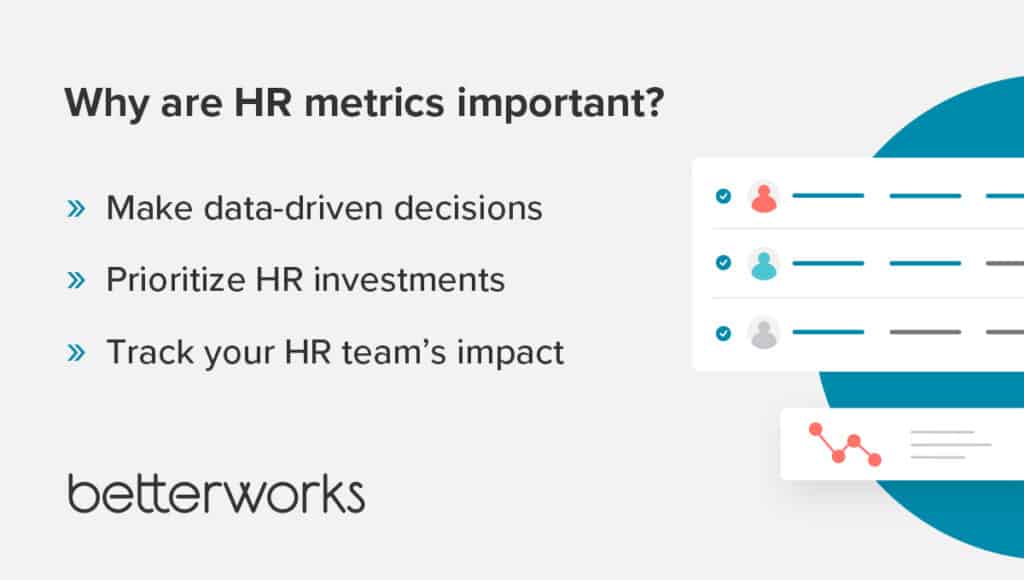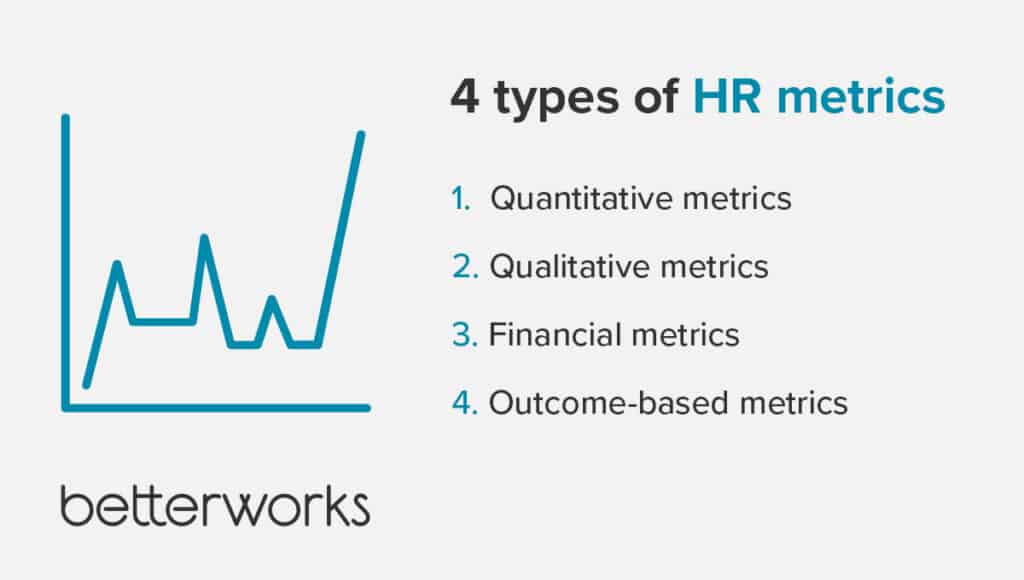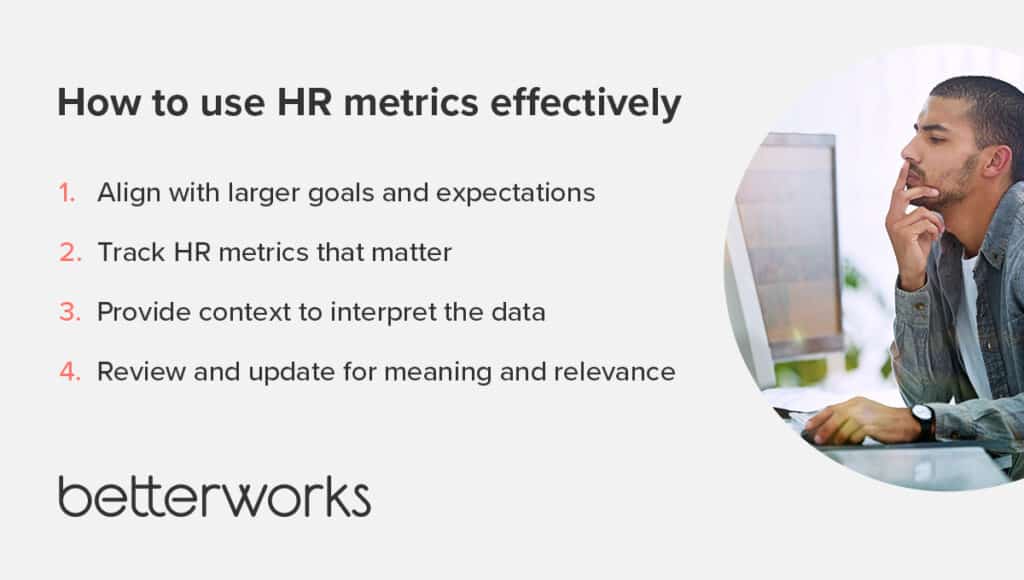Every action within your organization produces data — and all of that data has the potential to shape your human resources strategy. As an HR leader, it’s up to you to identify and pay attention to the HR metrics that matter most for your organization.
That’s more challenging in today’s workplace than ever before. Beyond data stemming from your HR information system (HRIS), your organization produces a wealth of HR and business data that could be useful to track. Most enterprise organizations have at least 21 separate data streams, according to the Academy to Innovate HR, with 11 of those outside your HRIS.
Sorting through that data to find the most meaningful information is one of the biggest challenges facing HR today. But with the right HR metrics, you can cut through the noise and focus on the numbers that matter most.
What are HR metrics?
HR metrics are measurable indicators used to track performance or progress toward a goal in your people strategy. They help businesses assess the success or failure of a particular action or process.
HR metrics vs. HR analytics
HR metrics are an essential part of a complete HR data strategy, but metrics alone don’t tell the whole story.
Instead, it’s best to consider them a crucial starting point for interpreting HR data and forming the foundation for your HR analytics program. Metrics are quantifiable measurements of a given activity, while analytics is the process of exploring and analyzing that data to gain insights and draw conclusions.
With HR metrics providing direction, you can make informed decisions about where to allocate resources to have the biggest impact.
HR metrics for performance management
Performance metrics contribute to the effectiveness of performance management systems and help measure the success of performance initiatives. These metrics provide HR departments with valuable information about employee performance that contributes to HR decision-making and strategy.
One of the most important applications of HR metrics in performance management is identifying areas where you can improve processes to drive higher performance. For example, a dip in employee engagement could suggest that team members don’t feel challenged by their work or need more frequent check-ins with managers. Alternately, analytics that show a particular team has many consistently top-performing members may yield insights about goal achievement manager-employee interactions that can be replicated in other areas of the organization.
That forward-thinking shift can be the first step toward evolving from traditional performance management toward a performance enablement model.
Why are HR metrics important?
HR metrics provide hard data to measure the effectiveness and efficiency of HR operations, making them a critical component of your HR strategy. Learn more about the ways HR metrics empower strategic HR functions.
Make data-driven decisions
Organizations are under immense pressure to stay competitive and need the ability to make data-driven decisions. HR metrics give HR leaders a clear picture of how their efforts affect the business. With a strong understanding of the data, you’re better equipped to make informed decisions that yield successful outcomes.
For example, measuring revenue per employee clearly shows how efficiently your people are contributing to top-line growth and how effectively the company is leveraging the workforce. With this information, you can better manage your workforce, adjust staffing levels, and make informed decisions about employee compensation and rewards.
Prioritize HR investment
Investments in your HR strategy and processes help the workforce function while supporting business goals. HR metrics help you prioritize these investments, as you can quickly learn how different areas of the workforce are performing and focus resources where they’ll have the greatest impact.
For example, you might find that new hires have a time-to-productivity rate that’s lower than the industry average. HR metrics related to the quality of job applicants and the success rate of recruiting efforts help you determine whether the problem lies with the quality of hire or a poor process for new-hire training. Armed with that data, you can decide whether to allocate resources to recruitment or training.
Track the HR team’s impact
HR metrics help you determine whether changes to your HR programs or new initiatives are successful. By tracking metrics before and after a change is made, you can see whether the change had the desired effect — and whether unintended effects occurred.
For example, to measure the impact of training and development initiatives, you might track performance improvement or employee satisfaction scores. Numbers that rise after implementing a learning and development program can signal the program’s success. Using analytics, you can track the upskilling of your employees over time to understand the ROI of your training programs.

Breaking down the types of HR metrics
HR metrics take many forms, and each can be used for different purposes. Check out a few of the types of HR metrics you’ll encounter in your practice.
Quantitative metrics
Quantitative HR metrics focus on numbers and data. Quantitative metrics produce precise numerical results. For example, use this formula to calculate employee turnover:
Divide the number of separations during a time frame by the average number of employees during that time, and multiply by 100.
A formula like this assigns clear numerical values to track over time to assess progress toward a larger objective. By monitoring and analyzing quantitative HR metrics, you can get a clear picture of what’s going on in the workforce and identify areas that need improvement.
Qualitative metrics
Qualitative HR metrics are typically based on data such as interviews, written responses, and focus groups rather than numerical data, which is numerical. Qualitative metrics for HR focus on aspects of the workforce that are harder to capture in quantitative data, such as the level of respect and trust between employees and management. For example, you can use metrics to detect issues with culture. By examining how different groups within your organization experience 1:1 conversations and feedback, you can understand where inequities exist and find opportunities to strengthen DEI&B programs and manager coaching.
Financial metrics
Financial HR metrics focus on the monetary impact of the HR function. These metrics include cost per hire, return on investment for training programs, and savings generated by employee retention initiatives. Financial HR metrics allow you to compare the costs and benefits of your HR programs, which informs resource-allocation decisions.
Outcome-based metrics
Outcome-based HR metrics focus on showing whether you’ve achieved the goal you set out to accomplish. These metrics look at concrete results to reveal what worked and what didn’t, rather than getting lost in the granular data of inputs and outputs.
One advantage of using outcome-based HR metrics is that they provide a holistic view of HR performance. By focusing on outcomes, these metrics illustrate the department’s overall effectiveness. They help you get a sense of success or failure in broad terms so you can decide where you need to focus your attention.

4 key HR metrics examples
HR tracks countless data points every day, but some are a higher priority than others. Here are a few of the most important HR metrics to keep your eye on.
Employee engagement
Employee engagement is a key HR metric organizations use to measure levels of motivation and engagement within the workforce. Active disengagement is one of the most concerning HR challenges facing employers today. There are many ways to measure employee engagement, including surveys, focus groups, and stay interviews.
Organizations typically use employee engagement data to assess employees’ feelings about the organization and their work. For example, employees who aren’t engaged are more likely to distance themselves from their work until they ultimately quit. Additionally, disengaged employees may be less productive and deliver lower-quality work.
Tracking employee engagement helps you stay alert to changes that could hurt your talent strategy. Day-to-day performance management is one of your best tools for engaging employees. If engagement is dropping, improving performance management processes could help.
Recruitment and retention
Recruitment and retention are two of the most important HR metrics. Recruitment measures how many new and high-quality employees an organization can bring in. There are many metrics that recruiters and talent acquisition teams use to manage the recruitment process. These include time to hire, time to fill, cost per hire, and quality of hire.
Retention looks at how long employees stay with the company. Some of the metrics used to assess retention include rates of voluntary turnover, involuntary turnover, and attrition.
Diversity and inclusion
Diversity and inclusion metrics are also essential to track but are among the most challenging to quantify. But we know what success looks like: When everyone feels included and respected for who they are, they’re more likely to be engaged and productive employees.
There are many ways to measure diversity and inclusion in your workplace. One common metric is comparing the percentage of employees from underrepresented groups with those who have greater representation. Underrepresented groups can include women, people of color, LGBTQIA+ individuals, and people with disabilities.
Another metric is the number or percentage of employees who feel they can be themselves at work. This is a qualitative metric that’s harder to pin down. Typically, HR leaders assess perceptions of inclusion through surveys or employee engagement data.
Diversity and inclusion continue to be a priority for stakeholders and shareholders alike. Tracking these metrics in your workforce is essential if you’re going to improve your culture effectively.
Employee turnover
Turnover can be a major problem for organizations. The costs of recruiting and training new employees add up, and losing the productivity and knowledge of experienced workers can eventually hurt your company’s bottom line.
There are many ways to measure employee turnover. The most common metric is turnover rate, which is the percentage of employees who leave your company in a given timeframe. Other metrics you can track include the total number of departures, departures per role or business unit, and voluntary versus involuntary turnover.
How to use HR metrics effectively
HR metrics are most effective when there’s a clear plan for using them. Explore some of the ways to make the most of HR metrics.
Align with larger goals and objectives
If you want your HR metrics to be effective, align them with the larger goals and objectives of your organization.
To align your HR metrics with organizational goals, map out your most critical organizational goals and identify which HR metrics illustrate progress toward them. For example, if a business goal is to differentiate your brand by providing top-tier customer service, you might track metrics like contact quality or first-call resolution.
Another way to use HR analytics is by identifying which business areas need improvement. Then, design your metrics accordingly. For instance, if you find that performance is dropping, you might examine the number of errors made or metrics that measure work efficiency.
Remember that HR metrics shouldn’t be used in isolation, whichever approach you take. They should always be considered in the context of other business metrics to get a complete picture of your organization’s performance.
Track HR metrics that matter
HR professionals are under pressure to track an ever-growing list of metrics, making it difficult to know which ones are most important. By tracking key metrics, you’ll get a clear picture of how HR policies are performing. You can then use this information to make necessary changes and improvements.
The first step is to identify the goals that you want to achieve with your HR metrics. Do you want to improve employee retention? Reduce turnover? Improve engagement? Once you’ve identified your goals, you can start to choose the metrics that’ll help you track progress.
In most cases, you’ll track several metrics from across data sources to find the answers you need. To track employee engagement, for example, you’ll start with your latest engagement survey results. Additional metrics such as participation in performance management conversations or absenteeism rates provide a complete picture of workforce engagement.
Provide context to interpret the data
HR metrics make more sense in context than in isolation. Without context, it can be difficult to determine the metric’s significance or assess how it compares with other metrics.
HR metrics, SHRM research shows, will differ in significant ways across organizations of different sizes. The average cost of hiring an employee at a small, specialized consulting firm will be significantly higher than the cost of hiring a front-line employee at a large retail chain. According to SHRM, HR metrics must be weighed against other factors in context, such as organizational size, industry, and company profitability.
Review and update for meaning and relevance
Tracking HR metrics is about having the right metrics for the moment and regularly reviewing and updating them to ensure that they’re still relevant and meaningful.
When reviewing HR metrics, always keep your organization’s goals in mind. What are you trying to achieve by tracking these metrics? Make sure that what you monitor aligns with organizational goals.
As your organization grows and changes, so should your HR metrics. Don’t wait until something goes wrong to review them. Set up a regular schedule, such as quarterly or semi-annually, to incorporate the latest advances or spot potential problems.
When reviewing and updating HR metrics, get input from other stakeholders, including managers and front-line employees. They can provide valuable insights into which metrics matter most and how to improve them.

Unlock business success with HR metrics
HR metrics are essential for businesses to measure their success and progress. They provide valuable insights into the performance of HR processes, the effectiveness of HR strategies, and the overall efficiency of HR operations. By tracking and analyzing HR metrics, businesses can identify areas of improvement and set realistic goals to achieve your highest-priority outcomes.
HR metrics are an invaluable resource for companies to ensure their HR strategies and performance management processes align with organizational goals — helping people be productive, efficient, and engaged.
Want to learn more about HR strategy? Discover 5 HR trends predicted for 2023.


